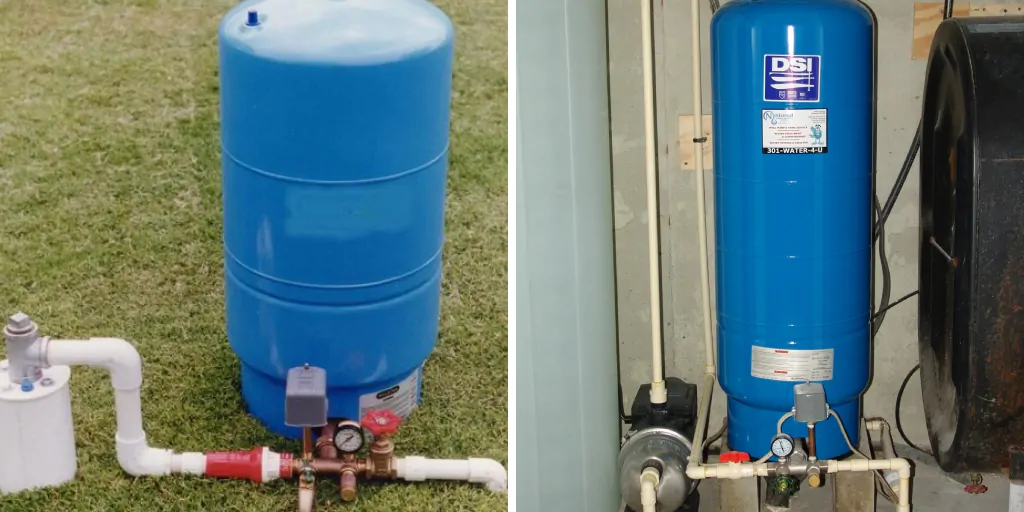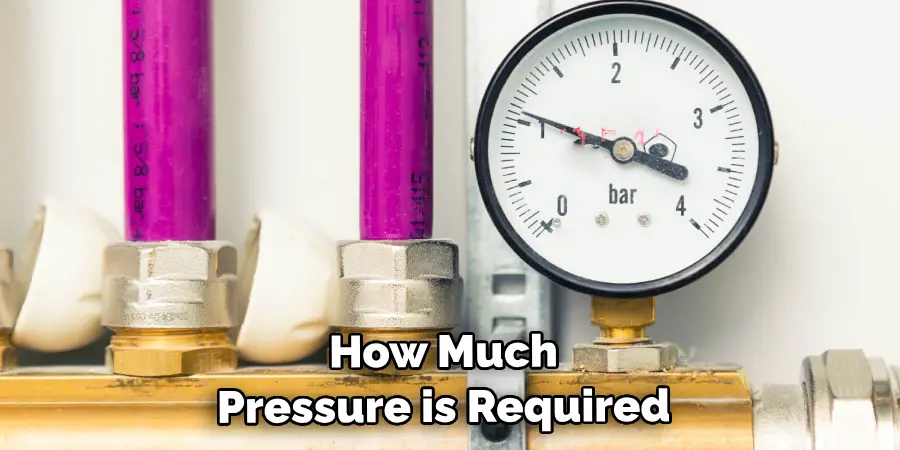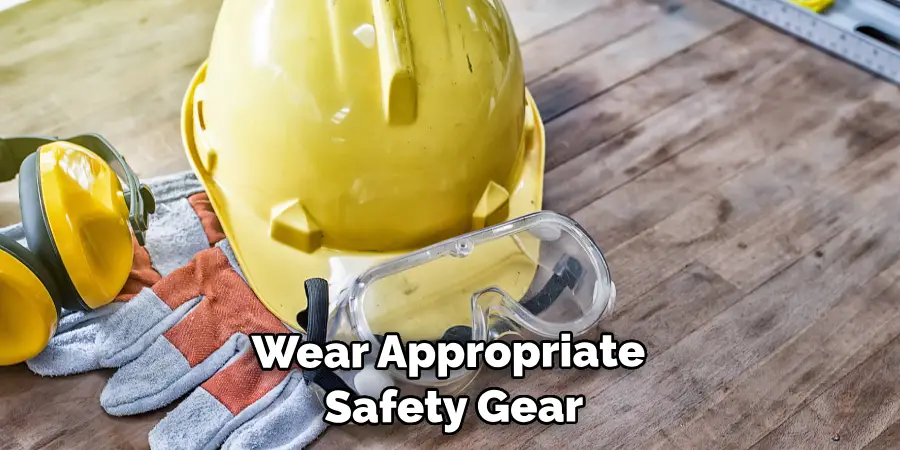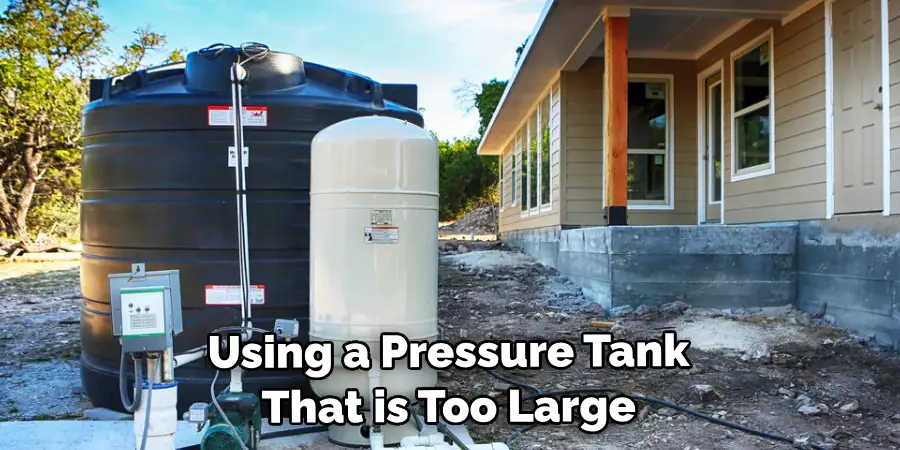A pressure tank is an essential equipment used in many applications such as water well systems, irrigation systems, and even household plumbing. The primary purpose of a pressure tank is to maintain consistent water pressure throughout the system by storing pressurized air and water. However, choosing the right size for your pressure tank can be quite challenging.

The main advantage of knowing to size pressure tank is that it allows you to ensure a steady and reliable water supply for your home or business. A correctly sized pressure tank will prevent issues such as low water pressure, pump cycling, and premature pump failure. This results in cost savings on repair or replacement of equipment. In this blog post, You will learn in detail how to size pressure tank.
Step-by-step Instructions for How to Size Pressure Tank
Step 1: Inspect Your Plumbing System
Before you start sizing a pressure tank, it is important to inspect your plumbing system. Look for any leaks or damages that may affect the overall performance of the system. Make sure all pipes are properly connected and in good condition.
Step 2: Determine Your Water Flow Rate
The first step in sizing a pressure tank is to determine your water flow rate. This is typically measured in gallons per minute (GPM) and can be found by using a flow meter on your main water line. If you cannot access a flow meter, you can estimate the rate by measuring how long it takes to fill a 5-gallon bucket with water.
Step 3: Calculate Your Peak Demand
Peak demand refers to the maximum amount of water that is needed at any given time in your household. This number can vary depending on the size of your family and the type of appliances you have. To calculate your peak demand, add up the flow rates of all the fixtures and appliances that may be used simultaneously.
Step 4: Determine Your Pressure Requirements

Next, you will need to determine how much pressure is required for your plumbing system to function properly. This is typically measured in pounds per square inch (PSI). Most homes require a pressure of 40-60 PSI, but it is important to check with your local plumbing codes.
Step 5: Calculate the Minimum Tank Size
To determine the minimum tank size for your pressure tank, you will need to use the following formula:
Minimum Tank Size = Peak Demand (GPM) x Drawdown Time (minutes)
Drawdown time refers to the amount of time it takes for your pressure tank to go from full to empty. This can be found in the manufacturer’s specifications.
Step 6: Consider the Pump Capacity
The size of your pump also plays a role in determining the overall size of your pressure tank. A larger pump may require a larger tank to accommodate its output. It is important to check the manufacturer’s recommendations for the appropriate tank size based on your pump capacity.
The pre-charge pressure refers to the amount of air present in the tank before it is filled with water. This amount can vary depending on the type of pressure tank you have. It is typically recommended to use 2 PSI below the cut-in pressure (the pressure at which the pump turns on).
Step 7: Calculate the Total Tank Volume
To calculate the total tank volume, you will need to add the drawdown volume and pre-charge volume together. The drawdown volume can be found in the manufacturer’s specifications, while the pre-charge volume can be calculated by using the following formula:
Pre-Charge Volume = (Pre-Charge Pressure / Cut-In Pressure) x Tank Capacity
Step 8: Check for additional requirements
In some cases, there may be additional requirements that need to be considered when sizing a pressure tank. This could include factors such as elevation, water temperature, or the type of pump being used. It is important to consult with a professional if you are unsure about any of these requirements.

After completing all calculations and considering any additional requirements, you should now have a recommended tank size for your plumbing system. Choose a pressure tank that meets or exceeds this size to ensure optimal performance and longevity of your system.
By following these step-by-step instructions, you can successfully size a pressure tank for your plumbing system. Remember to always consult with a professional plumber if you have any doubts or questions during the process. Properly sizing your pressure tank will help ensure the efficient and effective operation of your entire plumbing system.
Safety Precautions for How to Size Pressure Tank
- Always wear appropriate safety gear when working with pressure tanks, including gloves, goggles, and protective clothing.
- Make sure the tank is fully drained before beginning any sizing process to avoid potential accidents.
- Ensure that the area around the pressure tank is clear of any obstacles or hazards.
- Use manufacturer recommended tools and equipment for safe and accurate sizing of pressure tanks.
- Regularly inspect and maintain the pressure tank to prevent malfunctions and leaks.
- Seek professional help if you are unsure of how to properly size a pressure tank.
- Follow all safety guidelines provided by the manufacturer during installation and operation of the pressure tank.

By following these safety precautions, you can ensure a safe and successful process of sizing your pressure tank.
What Are the Maintenance Requirements for a Pressure Tank?
Proper maintenance is crucial for the longevity and optimal functioning of a pressure tank. Here are some key maintenance requirements to keep in mind:
- Regular Inspections: It is recommended to inspect your pressure tank at least once a year, or more frequently if needed. Look for any signs of damage, wear and tear, or leaks. Replace any faulty parts immediately.
- Cleaning: Keep the exterior of your pressure tank clean and free from debris to prevent corrosion and damage.
- Pressure Check: Regularly check the pressure levels in your tank to ensure it is functioning correctly. If the pressure drops significantly, there may be a leak or malfunction that needs to be addressed.
- Air Fill: Depending on the type of pressure tank you have, you may need to periodically add air to maintain the desired pressure levels. Consult the manufacturer’s instructions for guidance on how often this should be done.
- Check Valves: The check valves in your pressure tank are crucial for maintaining proper pressure levels and preventing backflow of water into your system. Make sure these valves are functioning correctly and replace them if necessary.

Proper maintenance not only ensures the safety of your pressure tank but also helps to prevent potential damages and saves you money in the long run. It is always better to be proactive with maintenance rather than dealing with costly repairs or replacements.
What Are Some Common Mistakes to Avoid When Sizing a Pressure Tank?
When it comes to sizing a pressure tank, there are a few key factors that need to be considered. These include the water usage demands of your household, the size of your well pump, and the type of pressure tank you choose. In this section, we’ll dive into some common mistakes people make when sizing their pressure tanks and how you can avoid them.
First and foremost, it’s important to understand that a pressure tank acts as a buffer between your well pump and the water system in your home. It helps to regulate the pressure and provide a consistent flow of water. With that in mind, here are some things to keep in mind when selecting the right size pressure tank for your needs.
1. Not Considering Water Usage Demand
One of the most common mistakes people make when sizing a pressure tank is not taking into account their household’s water usage demands. This can result in choosing a tank that is too small, leading to frequent pump cycling and premature wear on your well pump.
To avoid this mistake, it’s important to calculate your household’s peak water demand. This includes all faucets, appliances, and fixtures that may be in use at the same time. Keep in mind that different activities require different amounts of water, so it’s important to consider all potential scenarios.
2. Using a Tank That is Too Large
On the flip side, using a pressure tank that is too large can also cause issues. A larger tank holds more water, which means your well pump will have to work harder and potentially lead to unnecessary strain and wear. It can also take up more space and cost more money.

For residential use, it’s recommended to stick with a tank size that is appropriate for your household’s water usage demand. Oversizing the tank may seem like a good idea for ensuring enough water supply, but it can actually do more harm than good.
3. Not Accounting for the Type of Pressure Tank
There are two main types of pressure tanks: diaphragm and bladder tanks. Diaphragm tanks have a rubber membrane that separates air and water, while bladder tanks have a flexible plastic bag inside to separate the air and water. Each type has its own unique sizing requirements.
If you’re not familiar with the differences between diaphragm and bladder tanks, it’s important to do your research or consult a professional before making a decision. Choosing the wrong type of tank can result in incorrect sizing and potential issues down the road.
4. Neglecting Regular Maintenance
Proper maintenance is crucial for ensuring your pressure tank performs at its best. This includes checking the air pressure regularly, as well as performing any necessary repairs or replacements. Neglecting maintenance can lead to decreased efficiency and potential breakdowns.
By avoiding these common mistakes, you can ensure that your pressure tank serves its purpose effectively and efficiently. Remember to always consult a professional if you’re unsure about any aspect of sizing or maintaining your pressure tank.
Conclusion
In conclusion, understanding to size pressure tank is crucial for ensuring the smooth and efficient operation of any water system or pump. By properly sizing a pressure tank, you can prevent issues such as cycling, frequent pump starts, and water hammer. As discussed in this blog post, there are several factors to consider when sizing a pressure tank, including household water demand, pump flow rate, and desired pressure differential.
It is also important to select a tank with the appropriate size and material for your specific water system. Additionally, regularly monitoring and maintaining your pressure tank can help prolong its lifespan and prevent costly repairs or replacements in the future.
This includes checking for leaks, ensuring proper insulation, and properly adjusting the air pressure in the tank. I hope this article has been beneficial for learning how to size pressure tank. Make Sure the precautionary measures are followed chronologically.
You Can Check It Out to Replace Toilet Water Supply Line

